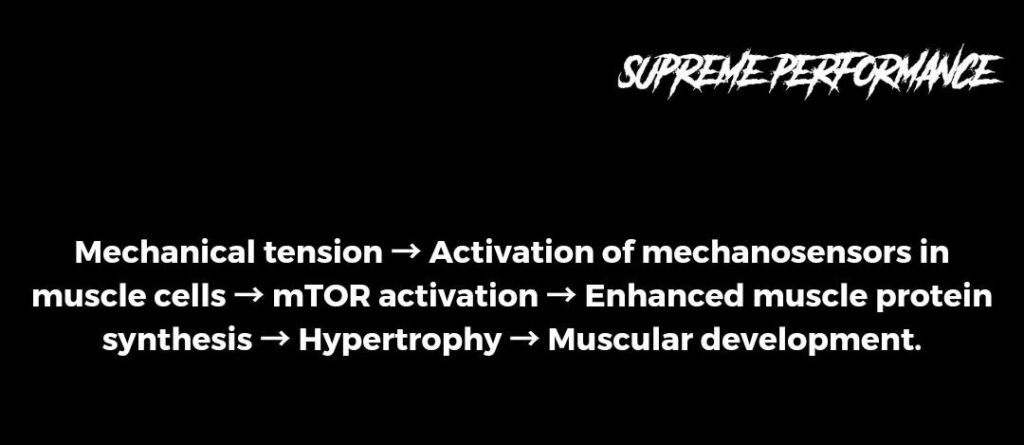THE SCIENCE OF HYPERTROPHY: HOW MUSCLES GROW AND ADAPT
The realm of muscle hypertrophy, the scientific term for muscle growth, is a captivating arena that draws the attention of both fitness enthusiasts and researchers alike. In this article, we delve into the intricate mechanisms that underlie the captivating phenomenon of muscle growth. From the cellular intricacies to the influential factors, we embark on a journey through the science that shapes the realm of hypertrophy.
Table of Contents
- Decoding Muscular Composition: A Glimpse into the Building Blocks
- Diving into the Depths: Unraveling Hypertrophy Types
- Blueprint of Myofibrillar Hypertrophy: The Pathway to Muscle Protein Growth
- The Path to Hypertrophy: A Visual Narrative
- Crafting Mechanical Tension
- Unraveling the Optimal Training Parameters
- Transient Hypertrophy: The Pump
- Lifting the Veil on Cellular Fatigue’s Role
- Progressive Overload: A Lighthouse on the Path to Growth
- Scientific Echoes of Progressive Overload’s Efficacy
- The Science of Failure in Training
- The Quest for Proper Failure Induction
- Insights from the Research Frontier
- Factors Affecting Failure-Induced Muscle Growth
- Comparing Failure to Near-Failure
- The Experienced Lifter’s Saga
- The Gameplan
Decoding Muscular Composition: A Glimpse into the Building Blocks
To fathom the science of muscle growth, we must first delve into the composition of muscle tissue. This complex mosaic is composed of various elements that interact harmoniously:
- Water: A dominant constituent, making up 60 to 80% of muscle tissue weight, water acts as the medium for countless cellular processes and sustains cell health.
- Glycogen: Representing up to 5% of muscle tissue weight, glycogen, a stored carbohydrate, serves as a vital energy reserve accessible during high-demand periods.
- Protein: At approximately 20% of muscle tissue weight, proteins are the building blocks that facilitate muscle contraction and repair.
Diving into the Depths: Unraveling Hypertrophy Types
- Myofibrillar Hypertrophy: This strand of hypertrophy spotlights the amplification of contractile proteins within muscle cells. The growth primarily occurs within myofibrils, the units that bring about muscle contractions. This type is intrinsically linked with strength gains and is triggered by mechanical tension.
- Sarcoplasmic Hypertrophy: On the other hand, sarcoplasmic hypertrophy centers around the expansion of non-contractile elements such as fluid and glycogen within muscles. While contributing to muscle size, it doesn’t directly influence strength gains.
Blueprint of Myofibrillar Hypertrophy: The Pathway to Muscle Protein Growth
Embarking on the journey of muscle growth necessitates a calculated sequence of steps. Each step initiates a chain of responses that culminate in the creation of new muscle tissue.
- Mechanical Tension Generation: At the core of myofibrillar hypertrophy lies the generation of considerable mechanical tension within muscle fibers. This tension arises from resistance training, subjecting muscles to external resistance during contractions. This stress-induced contraction acts as the catalyst for the growth process.
- Activation of Mechanosensors: In response to heightened mechanical tension, mechanosensors, specialized proteins within muscle cells, are triggered. These sensors are activated solely under intense tension, explaining the lack of significant stimulus during low-intensity activities. This activation sets the stage for the subsequent chain of events.
- Genetic and Hormonal Signaling: The activation of mechanosensors sets off a complex interplay of genetic and hormonal signals. These signals propel the body towards the initiation of muscle tissue construction. Among these is the increase in mTOR (mammalian target of rapamycin), an enzyme pivotal in stimulating protein synthesis – the creation of new muscle fibers. This collective response acts as a driving force for muscle protein growth. [1]
The Path to Hypertrophy: A Visual Narrative
- Mechanical Tension: At the heart of muscle hypertrophy lies the generation of mechanical tension, birthed through resistance training and muscle contractions. This tension sets off a sequence of events that culminate in muscle growth.
- Activation of Mechanosensors: As muscles experience mechanical tension, specialized proteins called mechanosensors are activated within muscle cells. These sensors act as messengers, transmitting the mechanical signal to cellular machinery.
- mTOR Activation: The activation of mechanosensors initiates a chain reaction, leading to the activation of a vital cellular regulator – mTOR (mammalian target of rapamycin). mTOR acts as a master switch, triggering various processes, including muscle protein synthesis.
- Muscle Protein Synthesis: The activation of mTOR prompts muscle cells to engage in protein synthesis, a process that involves creating new proteins essential for muscle growth. This influx of proteins contributes to the expansion of muscle fibers.
- Hypertrophy: The culmination of these processes results in hypertrophy – the enlargement of muscle cells. This growth transpires as proteins are assimilated into muscle fibers, resulting in augmented muscle size and strength.

Crafting Mechanical Tension
The catalyst for initiating hypertrophy lies in crafting substantial mechanical tension – best accomplished through heavyweight lifting. This approach exerts significant demand on muscle fibers, thus activating mechanosensors and instigating the hypertrophic journey.
Unraveling the Optimal Training Parameters
Weight Selection: For optimal hypertrophy, the sweet spot is training with weights ranging from 75 to 85% of your one-rep max (1RM). This intensity window allows for around 4 to 10 reps before muscle failure.
Volume of Tension: While a single heavy rep generates substantial tension, the duration or volume of tension also plays a pivotal role. Research indicates that there’s a minimal threshold of tension volume necessary to spur significant muscle growth.
Balancing the volume and intensity of training is crucial. For most individuals, the golden range hovers around 10 to 20 sets per muscle group per week. This volume sweet spot ensures a robust stimulus for muscle growth without teetering into overtraining territory.
Transient Hypertrophy: The Pump
During a workout, increased blood flow rushes to metabolically active areas, causing a temporary increase in muscle size. This phenomenon is known as transient hypertrophy, colloquially referred to as getting “pumped up” or experiencing “a pump.” The enhanced blood flow provides nutrients and oxygen to the muscles, creating a temporary swell. However, this size increase is short-lived and typically lasts for the duration of the workout.
Lifting the Veil on Cellular Fatigue's Role
Cellular fatigue emerges as an intriguing player in the choreography of muscle hypertrophy. This phenomenon manifests when muscles endure repetitive contractions, pushing them to the brink of exhaustion. As a response to this rigorous effort, a symphony of chemical changes takes place within muscle fibers and their surroundings. While the exact mechanisms remain enigmatic, studies suggest that cellular fatigue contributes to hypertrophy by enhancing muscle fiber activation, inducing cellular swelling, amplifying the hormonal response to exercise, or even triggering alternative pathways. However, it’s crucial to reiterate that while cellular fatigue contributes, mechanical tension remains the principal catalyst for driving muscle growth.
Progressive Overload: A Lighthouse on the Path to Growth
Progressive overload stands as a guiding principle in the realm of muscle and strength development. The concept revolves around exposing muscles to escalating levels of stress over time. This unrelenting challenge compels the body to adapt, resulting in enhanced muscle size, strength, and overall performance. The crux lies in the notion that muscles must encounter a stimulus surpassing their accustomed load to trigger growth.
Scientific Echoes of Progressive Overload's Efficacy
The scientific landscape resounds with evidence supporting the efficacy of progressive overload in fostering muscular hypertrophy. Studies underline that incorporating incremental weight increases proves highly effective. Gradually upping resistance amplifies the mechanical tension experienced by muscles, compelling them to respond with growth and augmented strength.
The Science of Failure in Training
The concept of training to failure has captivated fitness circles, sparking in-depth inquiries into its effects on muscle growth and strength gains.
However, the execution of studies on failure isn’t always uniform, sometimes leading to discrepancies. Instances abound where programs make it challenging to genuinely reach failure, rendering interpretations of study results complex.
The Quest for Proper Failure Induction
A study conducted at Amazon University showcases these hurdles. Participants engaged in multiple sets of high-rep squats until failure with minimal rest. Yet, the practicality of multiple failure sets with inadequate rest, as often occurs in squats, presents challenges.
Another frequent issue is the unequal volume between failure and non-failure groups. Often, the failure groups perform more sets, skewing the comparison. Such disparities taint the validity of conclusions drawn from these studies.
Insights from the Research Frontier
Some studies offer illuminating insights into failure-induced effects. A study with untrained young men found that training to absolute failure and stopping a few reps shy yielded nearly identical strength and muscle gains.
Factors Affecting Failure-Induced Muscle Growth
The impact of training to failure hinges on various factors. While beginners might thrive on training below failure due to “newbie gains,” seasoned lifters experience diminishing returns.
Comparing Failure to Near-Failure
A study with young untrained women focused on biceps curls. The outcome showed that training to failure didn’t yield more muscle growth than stopping a couple of reps before failure. This emphasizes the waning returns of training to failure, especially for novices.
The Experienced Lifter's Saga
An East Tennessee State University study explored training intensity in experienced lifters. Surprisingly, the group training to absolute failure performed worse than the near-failure group in most aspects. This outcome challenges the assumption that training to failure offers the ultimate path to growth. It highlights the significance of progressive overload and balanced training volume.
The efficacy of training to failure depends on various factors. In untrained individuals, the phenomenon of “newbie gains” suggests that even without pushing to absolute failure, substantial muscle and strength gains can be achieved. For experienced lifters, however, the benefits of intense training, including training to failure, are less pronounced.
The Gameplan
Over the past year I’ve come up with a progressive overload solution, that’s proven to be a game-changer for both my own progress and that of my clients.
By departing from the conventional and rigid 3×10 or 5×5 approach, and instead embracing a more flexible and dynamic rep range, such as 8-12 for example, has unlocked a pathway to easier and more effective progression.
I see it as a “bastardized linear approach” offering two potent strategies for maximizing progress:
- You have the option to increase the weight lifted in your subsequent session as sometimes you’ll feel strong and want to go heavier.
OR
2. You can choose to maintain the same weight as your previous training session while striving to exceed your previous rep count by 1-2 repetitions if you find yourself trending towards the lower end of the rep range, or by aiming to reach the upper end of the rep range. When you complete all of the prescribed reps at the higher end, increase the weight and rinse and repeat.
That way you autoregulate your training and make deloads practically non-existent or at least on a muscle specific basis when and if needed.
FAQ
Muscle tissue comprises water, glycogen, and protein. These elements work together to facilitate muscle contraction, energy storage, and repair.
Myofibrillar hypertrophy focuses on increasing contractile proteins within muscle cells, leading to strength gains. Sarcoplasmic hypertrophy involves expanding non-contractile elements like fluid and glycogen, contributing to muscle size but not strength.
The journey begins with generating mechanical tension through resistance training. This activates mechanosensors, igniting genetic and hormonal signals that stimulate muscle protein synthesis, resulting in muscle growth.
The optimal training intensity is around 75-85% of your 1RM, allowing for 4-10 reps before muscle failure. Balancing intensity and volume (10-20 sets/week per muscle group) is essential for effective muscle growth.
Progressive overload challenges muscles to adapt by exposing them to increasing stress over time. Gradually increasing weight or reps enhances mechanical tension, driving muscle growth and strength gains.
While training to failure isn't a strict requirement for muscle growth, my programs often utilize a range of techniques, including training to failure and even beyond failure. These methods have proven highly effective, adding variety and enjoyment to workouts while still achieving significant muscle development and strength gains.
Beginners often experience substantial gains without pushing to failure due to "newbie gains." Moderate intensity can still lead to effective muscle and strength development.
Embracing dynamic rep ranges (e.g., 8-12) allows flexibility. You can increase weight if feeling strong or maintain weight while aiming for more reps. This approach optimizes progression and reduces the need for frequent deloads.
Autoregulation helps adjust training intensity based on your body's response, allowing for better adaptation and minimizing plateaus. It offers a personalized approach to maximize muscle growth and strength gains.
Aim to progress in your workouts every 1-2 weeks. Listen to your body and adjust weights or reps accordingly to ensure a steady and sustainable path to muscle growth.



